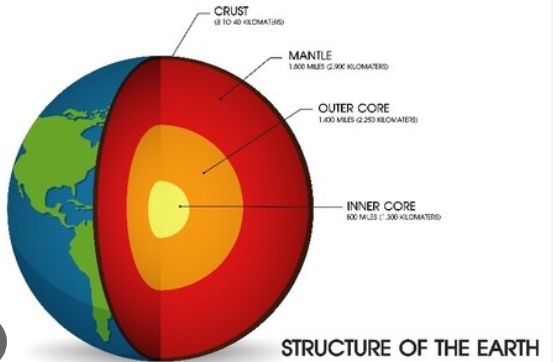
CBSE Class 7 Geography Notes Chapter 2: Students' understanding of the inside of our planet will be enhanced by the Class 7 Social Science Geography Chapter 2 Notes. It goes into great detail on the Earth's interior, different kinds of rocks and minerals, etc.
A wide range of fascinating subjects are covered in Chapter 2 of Class 7 Geography Inside Our Earth to aid students in understanding the idea of the Earth's innards. Interest-grabbing subjects include minerals, Earth's innards, rocks found on Earth, and much more. These facts about the planet's innards are crucial for students to learn because they will be covered in the exam. Our Chapter 2 of Geography for Class 7 Students can respond and remove any doubts they may have by using the notes to help them comprehend the concepts covered in the chapter.CBSE Class 7 Geography Notes Chapter 2 Overview
The planet Earth can be extremely dynamic. The Earth is constantly changing on the inside as much as the outside. Three main layers comprise the Earth's interior. The crust, mantle, and core are the names given to the layers. The crust of the Earth contains the majority of rocks. Igneous, sedimentary, and metamorphic rocks are the three primary types of rocks. The majority of minerals are found in nature and have certain physical characteristics in addition to their chemical makeup. The comprehensive coverage of these ideas in the Inside our Earth Class 7 Notes will aid students in understanding the material and improving their grades.CBSE Class 7 Geography Notes Chapter 2 PDF
CBSE Class 7 Geography Notes Chapter 2 discusses the interior of the planet as well as rocks and minerals, including different types of minerals and rocks. Understanding the facts about the planet we live on is crucial for students. Every subject is expertly explained with appropriate explanatory examples. If any idea is unclear to the students, they can also consult the CBSE Class 7 Geography Notes Chapter 2 PDF. These notes work well for students who need to quickly review the chapter's key ideas.CBSE Class 7 Geography Notes Chapter 2 PDF
CBSE Class 7 Geography Notes Chapter 2
Below we have provided CBSE Class 7 Geography Notes chapter 2 for the ease of students so that they can prepare better for their upcoming exams.Interior of the Earth
 Multiple concentric layers make up the Earth. The crust is the topmost layer that covers the surface of the earth. Out of all the layers, it is the thinnest. On the continental masses, it is roughly 35 km, but just 5 km on the ocean floor. Alumina and silica make up the majority of the continental mass's mineral composition. Thus, sial (si-silica and al-alumina) is the name given to it. Sima (si-silica and ma-magnesium) refers to the silica and magnesium that make up the majority of the oceanic crust.
The mantle is located at a depth of 2900 km below the surface of the Earth. The core, which has a radius of roughly 3500 km, is the outermost layer. It is called nife (ni = nickel and fe = ferrous, i.e. iron) and is mostly composed of nickel and iron. The pressure and temperature in the central core are quite high.
Multiple concentric layers make up the Earth. The crust is the topmost layer that covers the surface of the earth. Out of all the layers, it is the thinnest. On the continental masses, it is roughly 35 km, but just 5 km on the ocean floor. Alumina and silica make up the majority of the continental mass's mineral composition. Thus, sial (si-silica and al-alumina) is the name given to it. Sima (si-silica and ma-magnesium) refers to the silica and magnesium that make up the majority of the oceanic crust.
The mantle is located at a depth of 2900 km below the surface of the Earth. The core, which has a radius of roughly 3500 km, is the outermost layer. It is called nife (ni = nickel and fe = ferrous, i.e. iron) and is mostly composed of nickel and iron. The pressure and temperature in the central core are quite high.
Layers of Earth
The earth is made up of three different layers: the crust, the mantle and the core. This is the outside layer of the earth and is made of solid rock, mostly basalt and granite. Consider a cabbage as an illustration to comprehend the layers of the Earth. When cutting cabbage vertically, the outermost part of the vegetable is exposed before the layers of leaves. Its structure is comparable to Earth's.
The Earth is made up of three layers:
Consider a cabbage as an illustration to comprehend the layers of the Earth. When cutting cabbage vertically, the outermost part of the vegetable is exposed before the layers of leaves. Its structure is comparable to Earth's.
The Earth is made up of three layers:
Crust
The outermost layer of the Earth's surface Its main constituent is silicate. In the oceanic crust, it can have a thickness of 5 km, whereas, in the continental crust, it can reach 35 km. Beneath the sedimentary material that makes up this crust lie igneous, metamorphic, and acidic crystalline rocks. The lighter silicates, which are composed of a blend of silica and aluminum, make up the continents that cover the crust. Conversely, heavier silicates, such as silica + magnesium (Sima), make up the ocean crust. Roughly 1% of the Earth's total volume is made up of the crust.Mantle
Beneath the crust, the mantle has a thickness of around 2,900 km. It comprises about 66% of the Earth's mass and occupies 84% of the Earth's volume. It contains silicate that is high in magnesium and iron. As one approaches the middle, the temperature increases from 2,000 degrees Celsius to 40,000 degrees Celsius. The silicate material relaxes due to the high temperature without altering its characteristics. The Earth’s landscape is formed by the material being moved in different directions by the heat produced in the mantle zone. Tectonic plate movement is another effect of it, leading to earthquakes, seabed displacement, volcanic eruptions, and the development of mountains.Core
The geothermal gradient is produced by massive heat and pressure escaping from the Earth's core, which is more akin to a furnace. Nickel and iron make up the core. The liquid outer core and the solid inner core make up the two halves of the core. The churning of this liquid part produces and sustains the Earth's magnetic field. In contrast, the inner core is a dense ball of iron that is highly heated. The density and pressure in this area keep the iron from melting.Rocks and Minerals
A rock is a solid mixture of minerals that are firmly bound together. They are found in the natural world. Based on how they form, they can be divided into the following categories. One kind of rock created when lava or magma solidifies is called igneous rock. Rocks located in the crust or mantle melt to generate magma. It is divided into two categories. Rocks known as intrusive or plutonic rocks are created when lava cools and crystallizes inside the crust of the Earth. One example of a plutonic rock is granite. Extrusive or volcanic rock is the term used to describe rocks that are created when magma cools down after rising to the surface of the Earth in a dense, lava-like form. For example, basalt rock or pumice. Very minute fragments of fractured rock, minerals, and living things accumulate and cement together to produce sedimentary rocks in water. Shale, limestone, and sandstone are a few examples. Fossils are often seen in sedimentary rocks. When igneous or sedimentary rocks are exposed to extreme temperatures and pressures, their chemical makeup and physical characteristics change, resulting in metamorphic rock. Metamorphism is the term used for this. Marble, quartzite, and other like materials are instances of this.Extrusive Igneous Rocks
Extrusive igneous rocks: Lava quickly cools and solidifies upon contact with the earth's surface. Extrusive igneous rocks are those that have formed in this manner on the crust. Take basalt, for instance. Basalt rocks make up the Deccan plateau.Intrusive Igneous Rocks
Intrusive igneous rocks: Occasionally, molten magma cools down in the crust of the earth. We refer to these solid rocks as intrusive igneous rocks. One such type of rock is granite. Granite is used to make the paste or powder that is used to grind grains and spices.Minerals
Minerals are elements or compounds that exist in nature that have certain physical characteristics and unique chemical compositions. They provide enormous advantages to people. Minerals can be utilized in industry to create iron, aluminum, gold, and uranium, as well as fuels (coal, natural gas, and petroleum). They can also be utilized as mineral raw materials and fertilizers.Benefits of CBSE Class 7 Geography Notes Chapter 2
Our revision notes for CBSE Class 7 Geography Chapter 2 cover the essential concepts simply and comprehensively, helping students to fulfill their learning objectives. Our skilled teachers and subject matter experts have carefully chosen the notes we provide, catering to our students' demands for study resources that will help them complete their revisions with the least amount of effort and that are appropriate for tests. Students may easily study the chapter's main concepts and add further details as needed throughout the test with the help of these notes.CBSE Class 7 Geography Notes Chapter 2 FAQs
What is the name of chapter 2 in class 7 Geography?
CBSE Class 7 Geography Notes Chapter 2 - Inside our Earth.
What are crust class 7 notes?
The crust is the outermost layer and is defined as the solid Earth above the Mohorovicic discontinuity or, in short, simply Moho. The crust accounts for less than 1% of the Earth's volume, and the crust's temperature increases with depth.
What is the interior of the earth Class 7 short notes?
The interior of the Earth is made up of three distinct layers. The layers are referred to as the crust, mantle, and core. The majority of rocks are found in the Earth's crust. The three main categories of rocks are igneous, sedimentary, and metamorphic rocks.
🔥 Trending Blogs
Talk to a counsellorHave doubts? Our support team will be happy to assist you!

Free Learning Resources
PW Books
Notes (Class 10-12)
PW Study Materials
Notes (Class 6-9)
Ncert Solutions
Govt Exams
Class 6th to 12th Online Courses
Govt Job Exams Courses
UPSC Coaching
Defence Exam Coaching
Gate Exam Coaching
Other Exams
Know about Physics Wallah
Physics Wallah is an Indian edtech platform that provides accessible & comprehensive learning experiences to students from Class 6th to postgraduate level. We also provide extensive NCERT solutions, sample paper, NEET, JEE Mains, BITSAT previous year papers & more such resources to students. Physics Wallah also caters to over 3.5 million registered students and over 78 lakh+ Youtube subscribers with 4.8 rating on its app.
We Stand Out because
We provide students with intensive courses with India’s qualified & experienced faculties & mentors. PW strives to make the learning experience comprehensive and accessible for students of all sections of society. We believe in empowering every single student who couldn't dream of a good career in engineering and medical field earlier.
Our Key Focus Areas
Physics Wallah's main focus is to make the learning experience as economical as possible for all students. With our affordable courses like Lakshya, Udaan and Arjuna and many others, we have been able to provide a platform for lakhs of aspirants. From providing Chemistry, Maths, Physics formula to giving e-books of eminent authors like RD Sharma, RS Aggarwal and Lakhmir Singh, PW focuses on every single student's need for preparation.
What Makes Us Different
Physics Wallah strives to develop a comprehensive pedagogical structure for students, where they get a state-of-the-art learning experience with study material and resources. Apart from catering students preparing for JEE Mains and NEET, PW also provides study material for each state board like Uttar Pradesh, Bihar, and others
Copyright © 2025 Physicswallah Limited All rights reserved.







